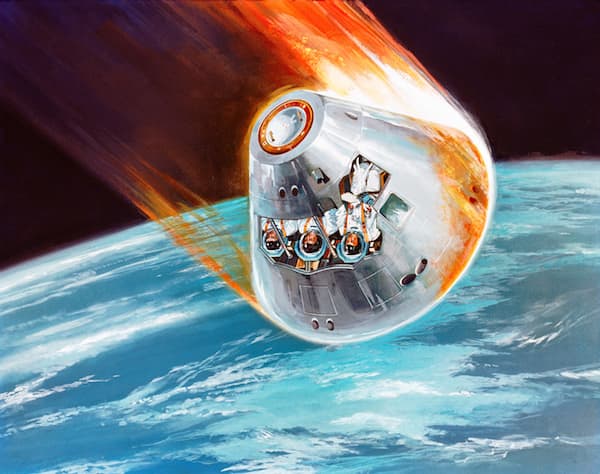Newly Designed Antenna To Avoid Communication Blackouts In Spacecrafts
As the big space research organisations across the world get ready to launch their upcoming missions, scientists are gearing up to better the existing technologies to support the spacecrafts in their long journeys to and fro. A researcher duo from Harbin Institute of Technology in China have proposed a novel way of avoiding communication blackouts in spacecrafts which are re-entering the Earth's atmosphere. In a situation of such a barrier in communication, the current state or location of the spacecraft can not be found. It is said that the blackout in Apollo 13 lasted for more than a minute. One can only imaging the level of anxiety that must have prevailed during that period.
Xiaotian Gao and Binhao Jiang are colleagues at Harbin. They found that communication blackouts occur in hypersonic vehicles as they travel at a speed 5 times the speed of sound. When a spacecraft re-entes the Earth's atmosphere, it is engulfed in a cloud of hot ionized air (known as 'plasma sheath'), which reflects any electro-magnetic signals coming towards it and thus cuts off the spacecraft's communication with an external source.

An artist's concept of a spacecraft re-entering Earth's atmosphere as a plasma sheath surrounds it and cuts off communication signals with the ground.
The researcher duo found that in certain specific conditions, the same plasma sheath can be used to enhance the radiation from a communication antenna. That means they can essentially turn an enemy into a friend and put it to good use.
To test their theories, Gao and his research team figured that they could redesign the antenna to make it operable in those special conditions in an ordinary hypersonic flight. The signal enhancement in antenna could be achieved by electromagnetic oscillations between the plasma sheath and the surrounding air.
Therefore, they proposed the addition of a 'matched layer' (which acts like a capacitor) to these antennas so as to create the desired conditions with the plasma sheath (that acts like an inductor). Pairing them together, they get a resonant circuit.
For the resonance to work, the team had to make thickness of the matched layer and the plasma sheath smaller than the electromagnetic wavelength. To do that, they created an automatic control system for the match layer to adjust to the change in the properties of the plasma sheath.
Although this isn't the first time that researchers have attempted to avoid the communication blackouts, the matched layer approach does have significant advantages over existing solutions.
For instance, the equipment to be installed is lighter, doesn't need extra energy to operate, doesn't need a particular shape of vehicle to work and as stated earlier, can adapt to the change of plasma sheath's properties.
What are your thoughts about the newly proposed re-designed antenna system? Share with us in comments below.
Source: <a href="https://www.aip.org/publishing/journal-highlights/communicating-hypersonic-vehicles-flight" target="_blank" rel="noopener noreferrer">Communicating with Hypersonic Vehicles in Flight | American Institute of Physics</a>
Xiaotian Gao and Binhao Jiang are colleagues at Harbin. They found that communication blackouts occur in hypersonic vehicles as they travel at a speed 5 times the speed of sound. When a spacecraft re-entes the Earth's atmosphere, it is engulfed in a cloud of hot ionized air (known as 'plasma sheath'), which reflects any electro-magnetic signals coming towards it and thus cuts off the spacecraft's communication with an external source.

An artist's concept of a spacecraft re-entering Earth's atmosphere as a plasma sheath surrounds it and cuts off communication signals with the ground.
To test their theories, Gao and his research team figured that they could redesign the antenna to make it operable in those special conditions in an ordinary hypersonic flight. The signal enhancement in antenna could be achieved by electromagnetic oscillations between the plasma sheath and the surrounding air.
Therefore, they proposed the addition of a 'matched layer' (which acts like a capacitor) to these antennas so as to create the desired conditions with the plasma sheath (that acts like an inductor). Pairing them together, they get a resonant circuit.
For the resonance to work, the team had to make thickness of the matched layer and the plasma sheath smaller than the electromagnetic wavelength. To do that, they created an automatic control system for the match layer to adjust to the change in the properties of the plasma sheath.
Although this isn't the first time that researchers have attempted to avoid the communication blackouts, the matched layer approach does have significant advantages over existing solutions.
For instance, the equipment to be installed is lighter, doesn't need extra energy to operate, doesn't need a particular shape of vehicle to work and as stated earlier, can adapt to the change of plasma sheath's properties.
What are your thoughts about the newly proposed re-designed antenna system? Share with us in comments below.
Source: <a href="https://www.aip.org/publishing/journal-highlights/communicating-hypersonic-vehicles-flight" target="_blank" rel="noopener noreferrer">Communicating with Hypersonic Vehicles in Flight | American Institute of Physics</a>
0
